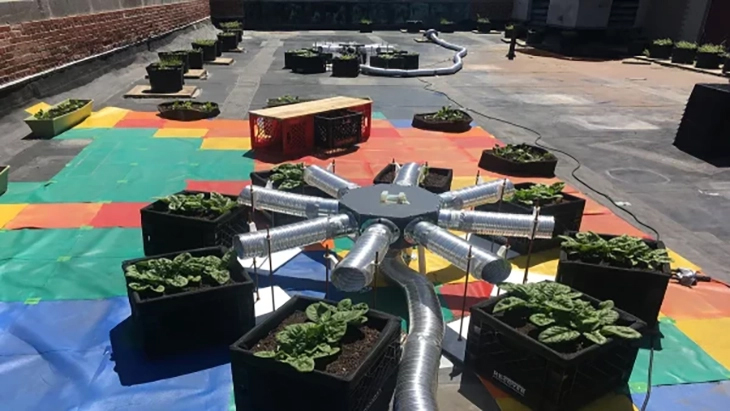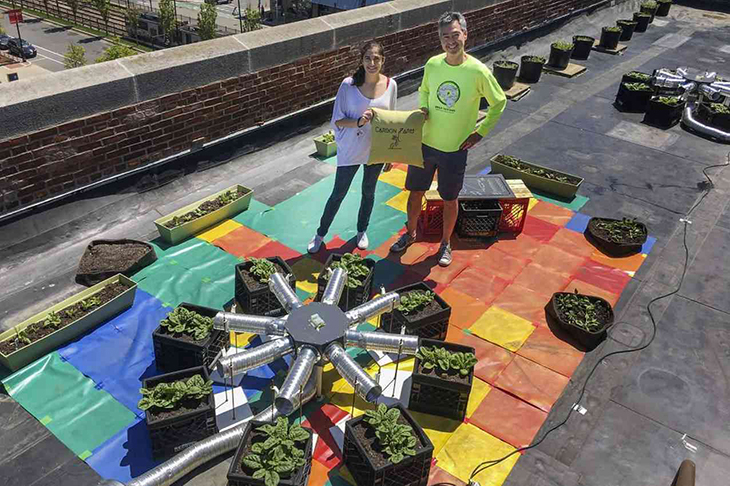
According to a new study, new carbon dioxide ventilators may possibly turn fumes into fertilizer in order to bring vegetable patches to high rise building rooftops.
While this wasn’t just suggested, the study also included an experiment that discovered how spinach, by new air vents, managed to grow four-times bigger than the other plants in the study. The scientists that conducted the study share that this is quite the breakthrough, and a promising develop to making city life healthier.
The research team, composed of scientists from Boston University, crated new technology that turns carbon dioxide (CO2) that’s pumped from building air vents into fertilizer that improves the challenging plant-growing environments for plant-life on rooftops.
There are hundreds of rooftop vegetable gardens, both big and small, that can found in a variety of cities all throughout the world. However, most of them are hydroponic systems, which means they get nutrients and water from a special mist that gets pushed and spread through tubes.
Many of these rooftop farms and garden supposedly help to improve the air quality of such cities, but the conditions tend to be quite difficult and harsh for some. More often than not, the plants that grow tend to be smaller or less healthy than others precisely because where they are situated tends to gain more solar radiation, have more wind exposure, and the soil where they are buried is usually drier than usual.
What the research group decided to do was intercede by repurposing the CO2 that’s usually emitted from the exhaust of the building into a fertilizer to help the plants grow.
According to the lead researcher on the study, Sarabeth Buckley, who is now with the University of Cambridge, the team started growing corn and spinach on a Boston University campus roof, an experiment they called BIG GRO.

She said, “We wanted to test whether there is an untapped resource inside buildings that could be used to make plants grow larger in rooftop farms. Creating more favorable conditions that increase growth could help make rooftop farms more successful and therefore more viable options for installation on buildings.”
The reason Dr. Buckley and the team chose spinach and corn to grow is because these are commonly edible plants that are also more sensitive to high levels of CO2 when they photosynthesize, as compared other plants. They also placed the plants closer to the exhaust vents of the building, while leaving another control near simple fans.
In the classrooms below, the CO2 levels were also measured regularly to find out how much extra CO2 the plants were getting. They found that there were high concentrations in both the rooftop exhaust vents and inside the classrooms when people were in the building.
Dr. Buckley went on to say, “CO2 levels averaged above 1000 parts per million—the recommended limit—in classrooms and above 800ppm—high enough to increase growth in plants—at the rooftop exhaust vents.”
As the plants grew, they were monitored in size, how many leaves they had, and their wet and dry biomass after they were harvested.
The scientists explained what was striking about the results of the experiment, which was also published in the Frontiers journal, saying that ‘spinach grown beside the exhaust vents had four-times the biomass of spinach grown next to a control fan.’ Moreover, the high winds also decreased the size advantage in some of the plants, although they were still twice as big as the control plants.
But Dr. Buckley forewarned that more work is still needed to be done before the system can be put into place.
She shared, “There are still many aspects of this system that must be determined before it can be implemented…” she said. “There is a decrease in growth with increased wind speed, so the optimal wind speed would need to be found and incorporated into the system design.”
“We are hoping this could lead to the further development of this system and eventual implementation in rooftop gardens and farms. If that happens, then hopefully more rooftop farms will be installed,” she added.
She concluded, “They could provide a multitude of environmental and social benefits such as energy savings for the building, carbon drawdown, climate mitigation, urban heat reduction, local food production, community building opportunities, and aesthetic and mental health benefits.”
What are your thoughts? Please comment below and share this news!
True Activist / Report a typo


